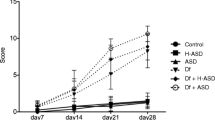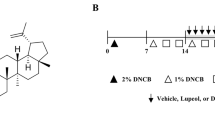Abstract
Background
Atopic dermatitis (AD) is a chronic inflammatory skin disease with biphasic T cell-mediated abnormalities. Staphylococcal superantigens contribute to the exacerbation of inflammation in AD. The underlying immunopathological mechanisms are not fully understood.
Objective
To determine whether epicutaneous application of recombinant staphylococcal enterotoxin A (rSEA) would exacerbate AD-like allergic inflammation induced by 2, 4-dinitrochlorobenzene (DNCB) and house dust mite extract (Dermatophagoides farinae extract, DFE) in a murine model.
Materials and Methods
We first established an AD-like model using BALB/c mice exposed to DNCB/DFE on the ear. Next, Staphylococcus (S.) aureus or rSEA were topically applied to the mice. We evaluated the clinical and histopathological features of the animals. Serum immunoglobulin levels were also measured. In addition, real-time PCR analysis of cytokines produced by T cell subsets in the earswas conducted.
Results
Mice treated with S. aureus and rSEA had more severe clinical symptoms, including increased mean dermatitis scores and ear thickness, compared to animals with only AD-like lesions. Total IgE, IgG2a and serum histamine levels were increased in all groups except the normal control group. The S. Aureus- and rSEA-treated groups showed increased levels of cytokines such as IL-4, IL-13, INF-γ, IL-17, and IL-18. In particular, increased cytokine expressionwas more conspicuous in the rSEA-treated group than in mice exposed to S. aureus.
Conclusion
The results of this study showed that topical exposure to rSEA as well as SEA-producing S. aureus aggravate atopic skin inflammation. This may be associated with the induction of a mixed Th1/Th2 type dermatitis.
Similar content being viewed by others
References
Pastar Z, Lipozencic J, Ljubojevic S. Etiopathogenesis of atopic dermatitis-an overview. Acta Dermatovenerol Croat 2005; 13: 54–62.
Yamamoto M, Haruna T, Yasui K, et al. A novel atopic dermatitis model induced by topical application with dermatophagoides farinae extract in NC/Nga mice. Allergol Int 2007; 56: 139–148.
Lubbe J. Secondary infections in patients with atopic dermatitis. Am J Clin Dermatol 2003; 4: 641–654.
Leyden JJ, Marples RR, Kligman AM. Staphylococcus aureus in the lesions of atopic dermatitis. Br J Dermatol 1974; 90: 525–530.
Ring J, Abeck D, Neuber K. Atopic eczema: role of microorganisms on the skin surface. Allergy 1992; 47: 265–269.
Lin YT, Wang CT, Chiang BL. Role of bacterial pathogens in atopic dermatitis. Clin Rev Allergy Immunol 2007; 33: 167–177.
Guzik TJ, Bzowska M, Kasprowicz A, et al. Persistent skin colonization with Staphylococcus aureus in atopic dermatitis: relationship to clinical and immunological parameters. Clin Exp Allergy 2005; 35: 448–455.
Nilsson EJ, Henning CG, Magnusson J. Topical corticosteroids and Staphylococcus aureus in atopic dermatitis. J Am Acad Dermatol 1992; 27: 29–34.
Proft T, Fraser JD. Bacterial superantigens. Clin Exp Immunol 2003; 133: 299–306.
Jung HJ, Jun JH, Cha HW, et al. Effect of topical application of staphylococcus aureus in the DNCB and dust mite extract-induced murine model with atopic dermatitis-Like Lesions. Korean J Dermatol 2011; 49(Suppl. 2): 124.
Kwon HK, Lee CG, So JS, et al. Generation of regulatory dendritic cells and CD4+Foxp3+ T cells by probiotics administration suppresses immune disorders. Proc Natl Acad Sci USA 2010; 107: 2159–2164.
Choi EJ, Lee S, Hwang JS, et al. DA-9601 suppresses 2, 4-dinitrochlorobenzene and dust mite extract-induced atopic dermatitis-like skin lesions. Int Immunopharmacol 2011; 11: 1260–1264.
Liu F, Lin LR, Zhang HL, et al. Laboratorial characteristics of patients with diarrhea suffering from egg white allergy. Allergol Immunopathol (Madr) 2013 Jul 11 [Epub ahead of print].
Shore PA, Burkhalter A, Cohn VH Jr.. A method for the fluorometric assay of histamine in tissues. J Pharmacol Exp Ther 1959; 127: 182–186.
Kim SH, Lee S, Suk K, et al. Discoidin domain receptor 1 mediates collagen-induced nitric oxide production in J774A.1 murine macrophages. Free Radic Biol Med 2007; 42: 343–352.
Karrer S, Bosserhoff AK, Weiderer P, Landthaler M, Szeimies RM. Influence of 5-aminolevulinic acid and red light on collagen metabolism of human dermal fibroblasts. J Invest Dermatol 2003; 120: 325–331.
Cardona ID, Cho SH, Leung DY. Role of bacterial superantigens in atopic dermatitis: implications for future therapeutic strategies. Am J Clin Dermatol 2006; 7: 273–279.
Kim DW, Park JY, Park KD, et al. Are there predominant strains and toxins of Staphylococcus aureus in atopic dermatitis patients? Genotypic characterization and toxin determination of S. aureus isolated in adolescent and adult patients with atopic dermatitis. J Dermatol 2009; 36: 75–81.
Tomi NS, Kränke B, Aberer E. Staphylococcal toxins in patients with psoriasis, atopic dermatitis, and erythroderma, and in healthy control subjects. J Am Acad Dermatol 2005; 53: 67–72.
Bunikowski R, Mielke ME, Skarabis H, et al. Evidence for a disease-promoting effect of Staphylococcus aureus-derived exotoxins in atopic dermatitis. J Allergy Clin Immunol 2000; 105: 814–819.
Yagi S, Wakaki N, Ikeda N, et al. Presence of staphylococcal exfoliative toxin A in sera of patients with atopic dermatitis. Clin Exp Allergy 2004; 34: 984–993.
Kim BS, Kim JY, Lim HJ, et al. Colonizing features of Staphylococcus aureus in early childhood atopic dermatitis and in mothers: a cross-sectional comparative study done at four kindergartens in Daegu, South Korea. Ann Allergy Asthma Immunol 2011; 106: 323–329.
Williams RE, Gibson AG, Aitchison TC, Lever R, Mackie RM. Assessment of a contact-plate sampling technique and subsequent quantitative bacterial studies in atopic dermatitis. Br J Dermatol 1990; 123: 493–501.
Gong JQ, Lin L, Lin T, et al. Skin colonization by Staphylococcus aureus in patients with eczema and atopic dermatitis and relevant combined topical therapy: a double-blind multicentre randomized controlled trial. Br J Dermatol 2006; 155: 680–687.
Guttman-Yassky E, Nograles KE, Krueger JG. Contrasting pathogenesis of atopic dermatitis and psoriasis-part II: immune cell subsets and therapeutic concepts. J Allergy Clin Immunol. 2011; 127: 1420–1432.
Liu FT, Goodarzi H, Chen HY. IgE, mast cells, and eosinophils in atopic dermatitis. Clin Rev Allergy Immunol. 2011; 41: 298–310.
Savinko T, Lauerma A, Lehtimaki S, et al. Topical superantigen exposure induces epidermal accumulation of CD8+ T cells, a mixed Th1/Th2-type dermatitis and vigorous production of IgE antibodies in the murine model of atopic dermatitis. J Immunol 2005; 175: 8320–8326.
Terada M, Tsutsui H, Imai Y, et al. Contribution of IL-18 to atopic-dermatitis-like skin inflammation induced by Staphylococcus aureus product in mice. Proc Natl Acad Sci USA 2006; 103: 8816–8821.
Hong SW, Kim MR, Lee EY, et al. Extracellular vesicles derived from Staphylococcus aureus induce atopic dermatitis-like skin inflammation. Allergy 2011; 66: 351–359.
Aral M, Arican O, Gul M, et al. The relationship between serum levels of total IgE, IL-18, IL-12, IFN-gamma and disease severity in children with atopic dermatitis. Mediators Inflamm 2006; 2006: 73098.
Bunikowski R, Mielke M, Skarabis H, et al. Prevalence and role of serum IgE antibodies to the Staphylococcus aureus-derived superantigens SEA and SEB in children with atopic dermatitis. J Allergy Clin Immunol 1999; 103: 119–124.
Ong PY, Patel M, Ferdman RM, Dunaway T, Church JA. Association of staphylococcal superantigen-specific immunoglobulin e with mild and moderate atopic dermatitis. J Pediatr 2008; 153: 803–806.
Kim MJ, Choung SY. Mixture of Polyphenols and Anthocyanins from Vaccinium uliginosum L. Alleviates DNCB-Induced Atopic Dermatitis in NC/Nga Mice. Evid Based Complement Alternat Med 2012 Oct 23. doi: 10.1155/2012/461989 [Epub ahead of print].
Matsushima Y, Kikkawa Y, Takada T, et al. An atopic dermatitislike skin disease with hyper-IgE-emia develops in mice carrying a spontaneous recessive point mutation in the Traf3ip2 (Act1/CIKS) gene. J Immunol 2010; 185: 2340–2349.
Koga C, Kabashima K, Shiraishi N, Kobayashi M, Tokura Y. Possible pathogenic role of Th17 cells for atopic dermatitis. J Invest Dermatol 2008; 128: 2625–2630.
Orfali RL, Sato MN, Takaoka R, et al. Atopic dermatitis in adults: evaluation of peripheral blood mononuclear cells proliferation response to Staphylococcus aureus enterotoxins A and B and analysis of interleukin-18 secretion. Exp Dermatol 2009; 18: 628–633.
Inoue Y, Aihara M, Kirino M, et al. Interleukin-18 is elevated in the horny layer in patients with atopic dermatitis and is associated with Staphylococcus aureus colonization. Br J Dermatol 2011; 164: 560–567.
Raap U, Weißmantel S, Gehring M, Eisenberg AM, Kapp A, Fölster-Holst R. IL-31 significantly correlates with disease activity and Th2 cytokine levels in children with atopic dermatitis. Pediatr Allergy Immunol 2012; 23: 285–288
Sonkoly E, Muller A, Lauerma AI, et al. IL-31: a new link between T cells and pruritus in atopic skin inflammation. J Allergy Clin Immunol 2006; 117: 411–417.
Akdis M, Trautmann A, Klunker S, Blaser K, Akdis CA. Cytokine and anti-cytokine therapies for psoriasis and atopic dermatitis. Acta Odontol Scand 2001; 59: 178–182.
Kasraie S, Niebuhr M, Werfel T. Interleukin (IL)-31 induces proinflammatory cytokines in human monocytes and macrophages following stimulation with staphylococcal exotoxins. Allergy 2010; 65: 712–721.
Author information
Authors and Affiliations
Corresponding author
Additional information
These authors contributed equally to this work.
About this article
Cite this article
Kim, B.S., Choi, J.K., Jung, H.J. et al. Effects of topical application of a recombinant staphylococcal enterotoxin A on DNCB and dust mite extract-induced atopic dermatitis-like lesions in a murine model. Eur J Dermatol 24, 186–193 (2014). https://doi.org/10.1684/ejd.2014.2302
Accepted:
Published:
Issue Date:
DOI: https://doi.org/10.1684/ejd.2014.2302




